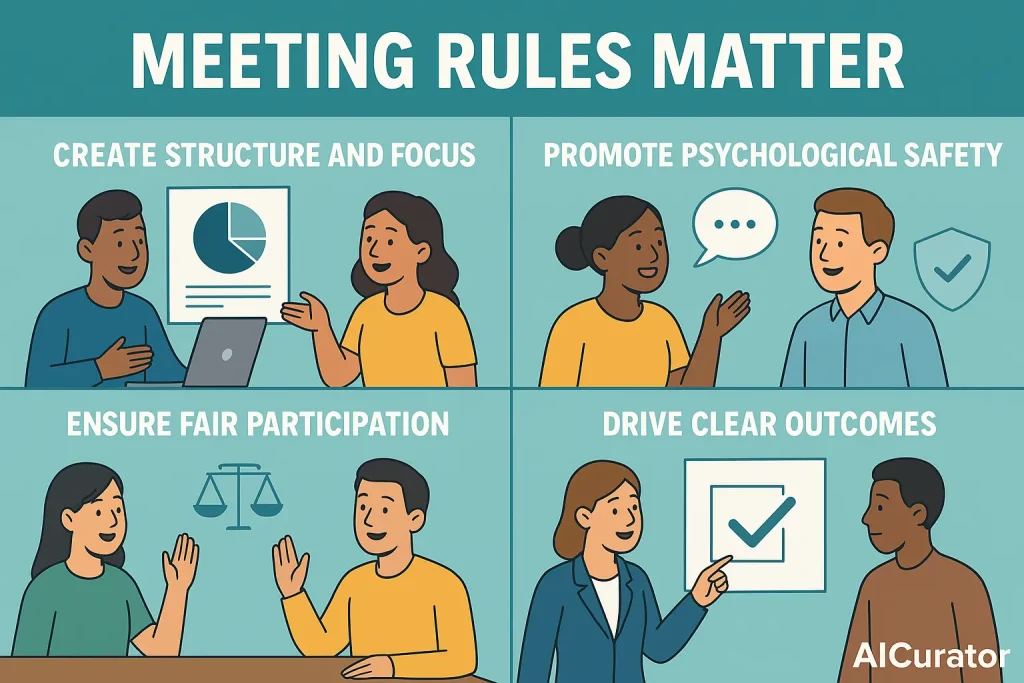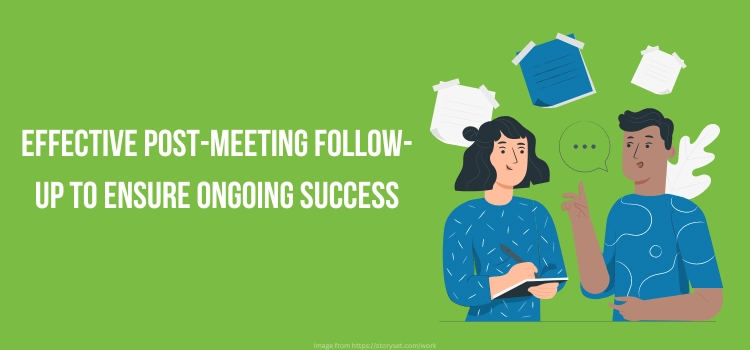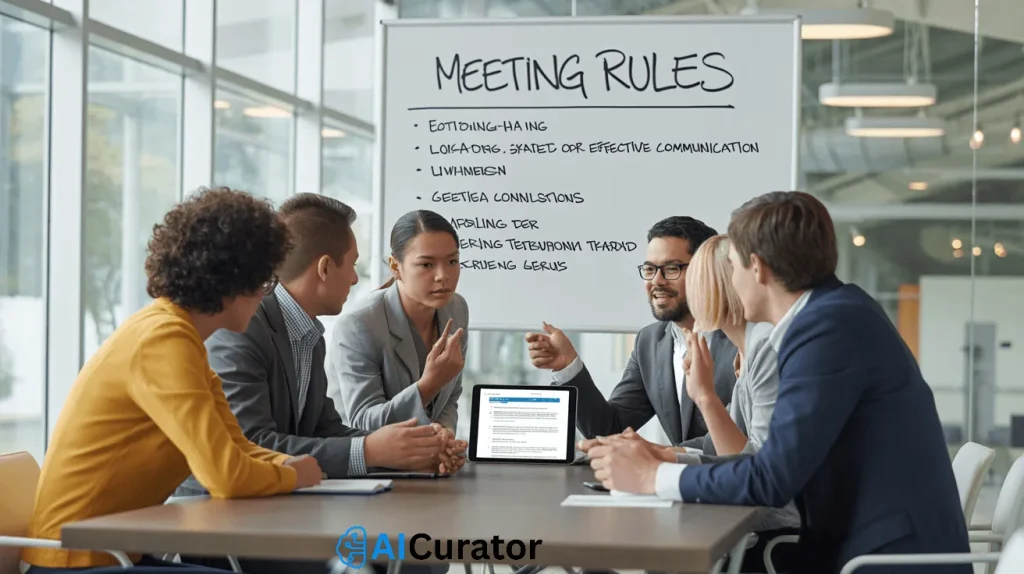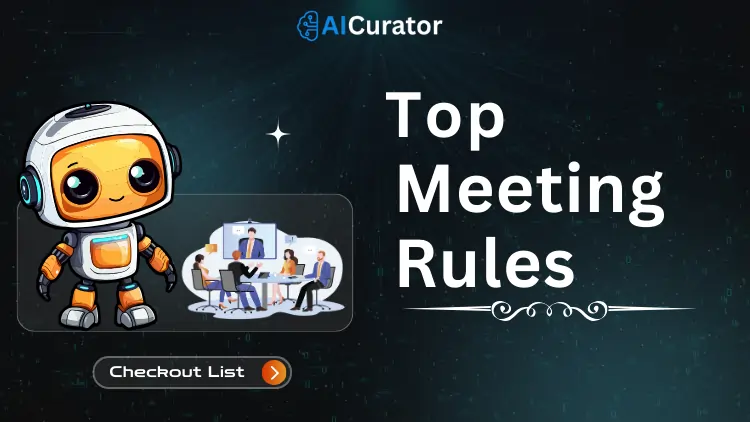How often do you leave a meeting feeling it could have been an email? We've all been there—stuck in discussions that drift without purpose, draining time and team morale.
From my experience, the most productive teams aren't the ones who meet less, but the ones who meet smarter.
The solution lies in a shared commitment to a few clear rules. This guide isn’t about strict regulations; it’s a practical framework to ensure every conversation is focused, every voice is heard, and every minute leads to meaningful action and better team communication.
Why Your Team Desperately Needs Clear Meeting Rules
Without a clear set of guidelines, meetings can easily become unproductive, leaving team members feeling frustrated and unheard. Clear meeting rules transform this chaos into focused collaboration. They are essential because they:

Ultimately, meeting rules are the foundation for turning mandatory check-ins into powerful sessions that boost team communication and drive real progress.
Proven Rules to Improve Your Team’s Meetings

To achieve truly superior team communication, these 10 essential meeting rules provide a clear framework—explained below, one by one, for your team’s success.
- Establish a Clear Purpose and Action-Oriented Agenda
- Be a Guardian of Time: Punctuality and Preparedness
- Cultivate Inclusive Participation: Every Voice Matters
- Master the Art of Active Listening
- Stay Laser-Focused: Keep Discussions on Topic
- Embrace Constructive Disagreement
- Use Technology as a Bridge, Not a Barrier
- Define and Assign Actionable Outcomes
- End with Clarity and Purpose
- The Post-Meeting Follow-Up: Cementing Success
1. Establish a Clear Purpose and an Action-Oriented Agenda
A meeting without a clear purpose is like a ship without a rudder. To ensure every meeting is productive, it must begin with a well-defined goal and a structured agenda. The agenda serves as a roadmap, keeping the discussion focused and ensuring that all critical topics are covered.

⁉️ Why it matters: A clear agenda sets expectations, allows participants to prepare in advance, and prevents meetings from devolving into aimless conversations. It transforms a vague gathering into a targeted work session designed to achieve a specific outcome, whether it's making a decision, brainstorming new ideas, or sharing important updates.
How to implement this rule
2. Be a Guardian of Time – Punctuality and Preparedness
Punctuality is a fundamental sign of respect for your colleagues' time. Starting and ending meetings on time shows professionalism and helps maintain a culture of efficiency. Equally important is coming prepared to contribute meaningfully to the discussion.
⁉️ Why it matters: When meetings consistently start late, it disrupts schedules and erodes team morale. Being unprepared can stall conversations and waste valuable time. Adhering to schedules and preparing in advance demonstrates respect and a commitment to the team's goals.
How to implement this rule
3. Cultivate Inclusive Participation – Every Voice Matters
The most effective solutions come from a diversity of perspectives. For meetings to be truly successful, every participant must feel empowered to share their thoughts and ideas. Creating an environment where all voices are heard prevents groupthink and leads to more innovative outcomes.

⁉️ Why it matters: When only a few people dominate the conversation, valuable insights from quieter team members can be lost. Inclusive participation ensures that decisions are well-rounded and have the buy-in of the entire team. It fosters a sense of psychological safety, where individuals feel comfortable speaking up without fear of judgment.
How to implement this rule
4. Master the Art of Active Listening
Effective communication is a two-way street. It's not just about speaking; it's about listening with intent. Active listening involves paying close attention to what others are saying, understanding their perspective, and responding thoughtfully.
⁉️ Why it matters: Active listening prevents misunderstandings, builds trust, and promotes a more collaborative environment. When team members feel heard and understood, they are more likely to be engaged and open with their ideas.
How to implement this rule
5. Stay Laser-Focused – Keep Discussions on Topic
While a good story can be engaging, meetings are not the place for long detours. To respect everyone's time and achieve the meeting's objective, it's crucial to keep discussions focused on the agenda.
⁉️ Why it matters: Tangents can easily derail a meeting, consuming time that was allocated for important decisions. Staying on topic ensures that the meeting remains productive and accomplishes its intended purpose.
How to implement this rule
6. Embrace Constructive Disagreement
Healthy conflict is a catalyst for growth and innovation. A culture where team members are afraid to disagree leads to groupthink and poor decision-making. Encouraging constructive debate allows ideas to be thoroughly vetted and strengthened .
⁉️ Why it matters: When team members feel safe to challenge ideas respectfully, the group can identify potential flaws, explore alternatives, and arrive at more robust solutions. This approach focuses on the problem, not the person, fostering an environment of intellectual honesty.

How to implement this rule:
7. Use Technology as a Bridge, Not a Barrier

In today's hybrid work environment, technology plays a critical role in how we communicate. When used effectively, digital tools can enhance collaboration and make meetings more inclusive. However, when they fail, they can become a major source of frustration .
⁉️ Why it matters: Reliable technology ensures that all participants, whether remote or in-person, can contribute equally. Tools that support collaboration can make meetings more dynamic and engaging, breaking down the barriers of physical distance.
How to implement this rule
8. Define and Assign Actionable Outcomes

A meeting is only successful if it leads to action. The ultimate goal of most meetings is to make decisions and define the next steps. Without clear, actionable outcomes, discussions remain just talk, and momentum is lost.
⁉️ Why it matters: Documenting action items creates accountability and clarity. When each task is assigned to a specific owner with a deadline, it ensures that the work gets done and progress is made after the meeting concludes.
How to implement this rule
9. End with Clarity and Purpose
How you end a meeting is just as important as how you begin it. A strong closing ensures that everyone leaves on the same page, with a clear understanding of what was accomplished and what happens next.
⁉️ Why it matters: The final minutes of a meeting are a critical opportunity to reinforce key takeaways and confirm alignment. A purposeful ending prevents confusion and solidifies the value of the time spent together.
How to implement this rule
10. The Post-Meeting Follow-Up – Cementing Success

The work of a meeting isn't over when everyone leaves the room. A timely follow-up is essential for maintaining momentum and ensuring that decisions are put into action.
⁉️ Why it matters: A follow-up email or message serves as an official record of the meeting, providing a reference point for all attendees. It reinforces accountability and keeps everyone aligned as they move forward with their assigned tasks.
How to implement this rule
By implementing these ten rules, you can transform your team's meetings from a source of frustration into a powerful engine for communication, collaboration, and success.
How to Implement Meeting Rules with Your Team?
Implementing meeting rules effectively is a team effort. Success depends on shared ownership, not top-down enforcement. Here’s a simple, helpful approach:

Your Blueprint for Better Meetings
Mastering meetings is about engineering better collaboration, not just talk. These ten rules are your new framework for turning sluggish huddles into high-output sessions—essential for any AI or tech project.
By setting sharp agendas, ensuring every voice is heard, and using tech smartly, you’ll drive real progress. Ready to upgrade your team's communication OS? Pick one rule to implement this week and watch the productivity spike. Drop a comment below with the rule you’re starting with.
Recommended Readings:
















